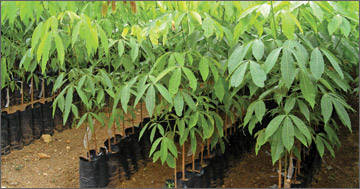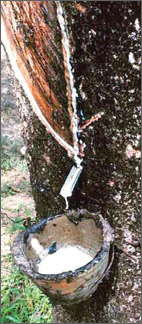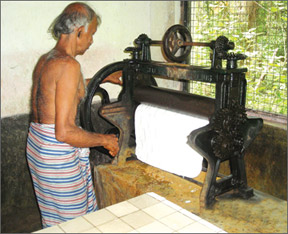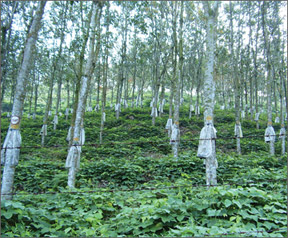Global warming threat to natural rubber
Dr N Yogaratnam
Global warming and climate change are aspects of our environment that
cannot be easily or quickly discounted.
Many factions still strongly feel that the changes our Earth is
seeing are the result of a natural climatic adjustment. Regardless of
oneís perspective the effects of global warming are a quantifiable set
of environmental results that are in addition to any normal changes in
climate. That is why the effects of global warming have catastrophic
potential.

Global warming may well be the straw that breaks the camelís back.
Global warming as caused by greenhouse gas emissions can lead us to a
definite imbalance of nature.
The premise of global warming as an issue of debate is that
industrial growth coupled with non-structured methods we as humans use
to sustain ourselves has created a situation where our planet is getting
progressively hotter.
We have seemingly negatively effected our environment by a cycle of
harmful processes that now seem to be feeding upon themselves to
exponentially increase the damage to our ecosystem.
Natural rubber
Natural rubber (NR) is mostly cultivated in the developing countries
in South and South East Asia, parts of South America and Africa falling
in the equatorial belt. These are some of the most populous nations in
the world and they are highly vulnerable to the adverse effects of
climate change. NR cultivation will not remain immune to the adverse
effects of global warming and climate change.

There are more than 10 million small growers who depend on NR
cultivation for their livelihood in these countries and climate change
has the potential to pose serious threats to their well-being.
Adverse effects of climate change can seriously diminish the supply
of NR and thus jeopardize the rubber goods manufacturing industry.
Shortage of NR will eventually result in increased consumption of
synthetic rubbers which will lead to increase in the emission of carbon
dioxide into the atmosphere.
Issues
During the past 30 years, it has been a realized that most of the
warming that has been observed is triggered by the release of carbon
dioxide through burning of fossil fuels. The evidence of human induced
climate change is accumulating every day.
Most glaciers are retreating and there is increase in the incidence
of heat waves and lower incidence of frost.
The pace of climate change will accelerate in the 21st century if
human beings continue to depend upon fossil fuels as the primary energy
source.
Some developed countries have not taken the threat of climate change
seriously because they think that they have the resources to adapt to a
warmer world. The major impact of climate change will be, however, seen
in the developing world where in many people will not have the resources
to adapt.
A warmer world will increase heat stress in tropical countries and
hence have an adverse impact on the performance of the workers in
industries. The rise in sea level will affect a large number of cities
located on the coast in Asian countries.
|

Rain and drought affect tapping days and disrupts harvesting.
The higher temperature
especially in the morning will affect latex flow and as a
result, the yield of rubber will be low.
Furthermore, climate change
may cause new diseases
which are detrimental to
rubber trees |
The changes in pattern of rainfall and higher evaporation will lead
to more water scarcity. The warmer night temperature will have an
adverse impact on agricultural production. The higher temperatures will
increase the incidence of attack by insects and pests on crops.
During the past 50 years the number of heavy rainfall events has
increased by almost 50 percent. This has lead to urban flooding. If the
global mean temperature increases by more than two degrees centigrade
above that in the 19th century, then the threat of an abrupt climate
change cannot be ruled out.
Abrupt climate changes have occurred in the past due to natural
causes but may be triggered by human actions in the future.
Many scientists and engineers have shown that we can move away from
our addiction to fossil fuels and meet our energy needs through
renewable energy technologies. The transition from the present fossil
fuel based society to one dependent only on renewable energy will be
slow and painful. We need, however, to take urgent actions now to
promote this transition in order to avoid irreversible changes to the
earthís climate
The major physical dimensions of climate change viz., global warming,
weather instability and occurrence of extreme and unusual climatic
events have short-term and long-term impact on supply of agricultural
crops and their price.
The magnitude of the impact of weather factors on price of a crop
would depend on the characteristics of the crop, nature and pattern of
weather factors in the major crop growing regions and market situation.
NR Yield
The latex yield of rubber trees is mainly determined by physiological
factors and harvesting intensity. Both these factors are influenced by
clonal characteristics, agronomic practices and environment. Given the
physiological factors and agronomic practices, the major yield-limiting
factor is harvesting intensity, which in turn is mainly determined by
weather and price factors.
|

Natural rubber (NR) is mostly
cultivated in the developing
countries in South and
South East Asia, parts of
South America and Africa falling
in the equatorial belt.
These are some of the most
populous nations in the world
and they are highly vulnerable
to the adverse effects of
climate change |
Extreme weather in terms of long and intense dry spells and heavy
rains can substantially reduce harvesting intensity through reduced
tapping days. The response of growers to the prevailing rubber prices is
also reflected in harvesting intensity.
The interplay of weather and price factors in determining NR
production makes it difficult to measure the influence of weather
factors on price.
The share of Asia in world NR production remained above 90 per cent
ever since the dominance of plantation rubber. But the relative shares
of Asian countries in world NR production changed considerably during
the recent decades.
Asian region
However, Southeast and South Asian regions accounted for 77.1 and
10.1 per cent of world NR production respectively in 2009. The tropical
regions of Southeast Asia are most vulnerable to climate change and
these regions face frequent storms and other extreme weather events.
The major expressions of climate change in the rubber South Asian
regions are decrease in the number of cool days and nights, increase in
the number of hot days and warm nights and decrease in the number of
rainy days per year.
Intermittent heavy showers and prolonged dry spells have marked the
weather in the recent years in South Asia with an accompanying increase
in average temperature. Incessant rains and flooding has also become a
regular event. The frequency of occurrence of natural disasters related
to extreme weather events also has risen globally and in South and
Southeast Asia. All these point to increased inter and intra year
variability in weather leading to instability in NR supply, which will
have a direct bearing on the NR market, mainly depending upon the demand
from the consuming industry
NR price
The impact of NR supply instability on price as a result of climatic
variations depends on market situations such as demand-supply balance,
marketing framework and factors influencing NR prices. The major factors
on the supply side are level of inventories and relative production in
relation to normal production. The normal production of NR is determined
by planted area, age of the trees and yield profile.
However, actual production would depend on weather and price factors;
the former directly affects tapping and the latter indirectly influences
tapping through grower behaviour. Relatively high levels of inventories
and actual production of NR being substantially below normal production
would lessen the impact of weather factors on NR price.
NR is mainly used globally in the transportation sector as tyres and
other auto components. The transportation sector is highly sensitive to
the trends in the world economy. The balance between NR demand and
supply is a crucial factor determining the impact of weather factors on
price particularly when the economy is on a strong footing. The
increasing process of market integration has led to more harmonisation
of commodity price trends around the world. For example, the emergence
of TOCOM price as an international trendsetter in NR market.
The sentiments of market players in TOCOM are easily influenced by
weather events occurring in major rubber growing areas of Southeast Asia
and these sentiments get reflected in TOCOM rubber prices, almost
instantly.
The trends in TOCOM rubber prices percolate into the South and
Southeast Asian rubber markets with immediate effect
Influencing factors
There are several factors apart from demand-supply balance and
marketing framework that can influence the price of NR and these include
price and supply of substitutes, oil prices and currency exchange rates.
But with environmental virtues in terms of CO2 sequestration etc of tree
crops gaining importance, the influence of synthetics, crude oil etc,
which causes emission of Green House Gasses (GHG), may be insignificant.
Therefore, weather induced supply disruptions may have overriding
role on NR supply and price.
Nevertheless, during the current decade, world NR production was
adversely affected by extreme and unusual weather conditions especially
in 2005, 2007 and 2009. But, the same period also witnessed very low
rubber prices, recovery and boom which were primarily due to shifts in
global economy.
NR production
There was a structural shift in NR prices from the late 1970s. The
prices of NR reached a peak at the end of 1970s. In response to the
booming prices, in the beginning of 1980s, a large scale new-planting
and replanting of rubber happened in all major producing countries.
These new-planted and replanted rubber trees were expected to attain
the replanting age from 2010 onwards, assuming a productive life span of
rubber is 30 years.
To push the existing yielding area into a gestation phase, in 2003-09
there were a large-scale replanting in non-traditional regions,
considering that the new-planting undertaken in the beginning of 1980s
would enter the declining phase in 2010 because of ageing.
These new-planted and replanted areas in 2003 and 2004 would
marginally add the global supply from 2010 to 2011. From 2012 to 2016 a
substantial addition of supply is expected according to the
new-planting/replanting which was undertaken from 2005 to 2009.
On the other hand, the new-planting and replanting undertaken during
2003-09 were mostly in non-traditional regions. These areas are
agro-climatically marginal to grow rubber and their productivity are not
expected to be significantly high.
Other limitations
The other limitations to improve the yielding areas are i) the
existing areas are still occupied by low-yielding clones, ii) shortage
of skilled tappers, iii) unscientific harvesting practices and iv)
climate change. Spiraling wages, cost of input materials, lack of
mechanical harvester etc can cause shortage of skilled tappers and
scientific harvesting workers.
Hence, the existing marginal growers should be skilled in tree
improvement, vegetative propagation, latex harvesting and processing
technologies and so on.
Lack of other sources of income can cause postponed replanting of the
aged trees especially when the rubber prices are high. In addition, the
existing gap between prices of NR and SR is also a threat to the NR
supply.
Climate change would have a negative bearing on future yield. Rain
and drought affect tapping days and disrupts harvesting. The higher
temperature especially in the morning will affect latex flow and as a
result, the yield of rubber will be low.
Furthermore, climate change may cause new diseases which are
detrimental to rubber trees. The existing clones that have tolerance to
climate change is limited.
Therefore, it is necessary to develop clones which are tolerant to an
extreme climate.
Road ahead
To accommodate the issues and challenges in global supply of NR, some
adjustments to improve the yield of rubber are needed. Mechanization for
harvesting and processing is preferable to improve the quality of
harvested rubber.
Dissemination of market information can be used to strengthen the
existing system. Government incentives for replanting can minimize the
ageing issues and attract farmers from rubber holding.
Early morning tapping
Over the years climate has undergone major changes in the areas where
its rubber estates are located. Both the early morning (minimum)
temperature and afternoon (maximum) temperature have gone up in recent
years. It is felt that this has substantially affected the growth rate
and productivity of estates.
Generally, tapping starts in rubber estates by 6.30 am and latex
collection would start at 10.00 am and it will be over by 12.00 noon.
Considering that the morning temperatures have gone up in the recent
years and knowing that cooler temperatures will favour better yield.
Some reports indicate that commencement of tapping to 3.00 am has
resulted in 20 to 30 per cent increase in productivity with substantial
reduction in the percentage of field coagulum.
It is suggested that likely higher turgor pressure prevailing in the
cooler hours of early morning was responsible for the better yield.
Since the latex was collected only after sunrise there was adequate
time for dripping to stop and therefore the percentage of field coagulum
was less. Early morning collection of latex ensured better preservation
of latex due to the congenial temperature during this time. In order to
carry out effective tapping, the tappers were provided with superior
quality headlights and better tapper productivity led to 20 per cent
more earnings for the tapper. The increase in production and
productivity ensured that the investment in these equipments was paid
back within a period of less than a week in most cases
Nutrient balance approach
Nitrogen (N) is required in substantial amount in order to support
growth and must be adequate to produce economically sufficient rubber
yield. N constitutes 3-4 per cent of leaf dry matter. In both young and
mature rubber, N deficiency tends to produce small and yellowish leaves
resulting in stunted growth.
When the amount of soil N is deficient for satisfactory rubber
yields, N fertiliser is added to supplement the soil N. If N is supplied
in excess, it leads to environmental problems. When applied into the
field, N fertiliser is largely converted to nitrate and this form is
soluble and readily moves with the soil solution. This surplus N may be
available to leach to groundwater. Alternately, N can also contribute in
the nitrate, ammonium or organic form to surface water contamination by
means of surface water runoff.
The other problem encountered from using N fertilizer is Green House
Gas (GHG) emissions, as nitrate can be transformed into NH3, NO3, N2O,
N2 etc. through mineralization process. As part of an effort to reduce
environmental pollutants along with the emissions of GHG from using N
fertiliser in rubber plantations, a nutrient balance approach is
suggested.
It has also been reported that under short dry spell both Silicon (Si)
and K were effective in reducing the adverse effects of drought stress.
However, under prolonged water stress, K was more effective than Si.
Tillage as well as life saving irrigation has been found to be effective
in India. But, tillage is a more economic and feasible management
practice in Sri Lankan plantations. Tillage is expected to provide
additional soil conservation measure by blocking capillary pores in the
soil.
In conclusion, export must orient to more finished rubber-based
products than raw rubber, thus improving net farm income. More site
specific technologies to maintain the existing yielding areas from
negative effect of climate change together with other scientific
practices should be evolved. |



